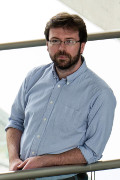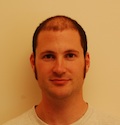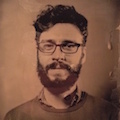Instructors
The course will be taught by:
Gavin L Simpson
 Gavin is a research scientist at the Institute of Environmental Change and Society, University Regina, Canada. He started using R (just) before version 1.0 was released and maintains several R packages as well as contributing to and helping to maintain the popular
Gavin is a research scientist at the Institute of Environmental Change and Society, University Regina, Canada. He started using R (just) before version 1.0 was released and maintains several R packages as well as contributing to and helping to maintain the popular vegan package. A (palaeo)limnologist and (palaeo)ecologist by training, Gavin is particularly interested in community dynamics in time (OK, and space) and as such invariably finds himself fitting non-linear models to stubbornly-complicated time series data with mgcv.
Noam Ross
 Noam is a disease ecologist at EcoHealth Alliance in New York. He works on both the theoretical and empirical sides of in the dynamics of disease circulation in wildlife populations and spillover to humans. He uses
Noam is a disease ecologist at EcoHealth Alliance in New York. He works on both the theoretical and empirical sides of in the dynamics of disease circulation in wildlife populations and spillover to humans. He uses mgcv for both analysis of disease time-series and multivariate analysis of macroecology. He has been using R for eight years, and serves as editor for rOpenSci, a community project to peer-review R packages.
Course Partners
The course was also developed by
Eric J Pedersen
 Eric Pedersen is a research scientist with Fisheries and Oceans Canada (DFO) Newfoundland and Labrador. He works on statistical and theoretical models of movement and community dynamics, and has been using R for his work for almost 10 years. He’s currently pretending to be a fisheries ecologist, but has worked with everything from forest recruitment patterns to marine larval dispersal to human movement. He uses
Eric Pedersen is a research scientist with Fisheries and Oceans Canada (DFO) Newfoundland and Labrador. He works on statistical and theoretical models of movement and community dynamics, and has been using R for his work for almost 10 years. He’s currently pretending to be a fisheries ecologist, but has worked with everything from forest recruitment patterns to marine larval dispersal to human movement. He uses mgcv to model nonlinear functional relationships, complex spatio-temporal patterns, and test mechanistic models.
David L Miller
 Dave is a researcher at I am going to be working at the Commonwealth Scientific and Industrial Research Organisation (CSIRO) in the Hobart Marine Laboratory, Tasmania Having completed his PhD with Simon Wood in 2012, he’s spent a lot of time thinking about how to model the spatial distribution of animal populations, most recently North Atlantic right whales.
Dave is a researcher at I am going to be working at the Commonwealth Scientific and Industrial Research Organisation (CSIRO) in the Hobart Marine Laboratory, Tasmania Having completed his PhD with Simon Wood in 2012, he’s spent a lot of time thinking about how to model the spatial distribution of animal populations, most recently North Atlantic right whales. mgcv is his go to tool for building complex spatial models.